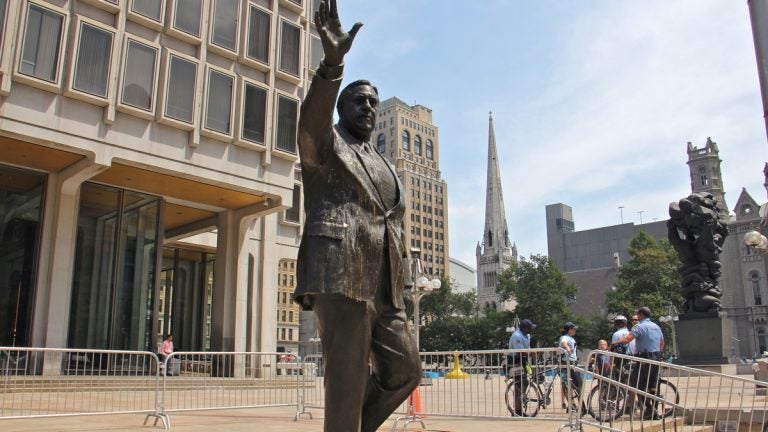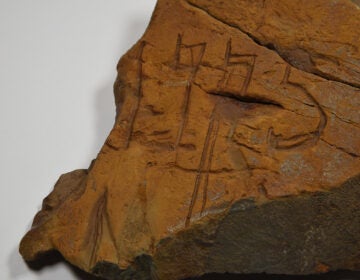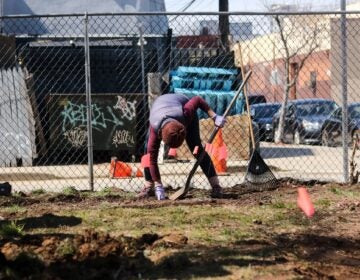A historian on the Rizzo debate: ‘It comes down to what statues do’
Controversy surrounding the 10-foot-tall statue of former Mayor Frank Rizzo across from City Hall has rekindled in recent weeks

Police stand guard at the Frank Rizzo statue on the grounds of the Municipal Services Building. (Emma Lee/WHYY, file)
This story originally appeared on PlanPhilly.
—
Controversy surrounding the 10-foot-tall statue of former Mayor Frank Rizzo across from City Hall has rekindled in recent weeks, as it’s become clear that the figure will not be moved or removed any time soon.
The renewed attention to the debate coincides with the release of a new book by historian Timothy Lombardo, “Blue-Collar Conservatism: Frank Rizzo’s Philadelphia and Populist Politics.”
A native of Northeast Philadelphia, Lombardo is now a professor of history at the University of South Alabama.
“I live and teach in the South now, so I’m mostly asked about Confederate statues, but the situations are similar,” Lombardo said in an interview.
“It comes down to what statues do. No one learns history from a statue. What you learn from a statue is respect and reverence. The question for the present is: Are the people these statues are honoring worthy of respect and reverence?”
Calls for removing the Rizzo statue were first heard from City Councilwoman Helen Gym a year ago, when she cited the former mayor and police commissioner’s racially polarizing political career as well as his history of heavy-handed police tactics.
Mayor Jim Kenney attempted to reach a compromise that would have moved the statue to South Philadelphia. That idea was greeted with disdain from Rizzo supporters, including his son, former City Councilman Frank Rizzo Jr.
“As police commissioner, he served the entire city,” Rizzo Jr. told Philadelphia Inquirer and Daily News columnist Stu Bykofsky. “As mayor, he served the entire city. My dad loved South Philadelphia, but he served all of Philadelphia.”
Lombardo said the controversy is understandable. The onetime mayor’s populist appeal was specifically targeted to residents of segregated white rowhouse neighborhoods. Rizzo pitched himself as a symbol of white identity politics, and didn’t often go to black neighborhoods during his 1970s political campaigns.
But Rizzo did not try to appeal to white voters by using overtly racist language, and he had black bodyguards and other confidants, which his defenders cite as proof that he was not racist.
Rizzo himself argued a similar line. “If there’s one thing I’m not, it’s against somebody because they are a Negro or an Irishman or anything else,” he said in an interview with Philadelphia magazine in the 1960s. “Hell, I’m an Italian. I’ve known a lot of good Negro cops.”
Lombardo said the question of whether Rizzo was personally racist isn’t the right one to be asking. It draws focus away from the actual policies he pursued, which were extremely racially divisive.
Those included early support of “stop-and-frisk” police tactics, ferocious resistance to desegregation of the city’s school system, and largely successful efforts to prevent public housing — at that time, almost exclusively populated by African-Americans — in majority white neighborhoods.
Lombardo said Rizzo’s platform of white identity politics and racially charged appeals could be seen in the most hyperlocal decisions. In one case his book details, Rizzo’s Department of Parks and Recreation padlocked the entrance to Lanier Playground closest to the mostly black Tasker Homes public-housing complex, while the entrance closest to the mostly white Grays Ferry neighborhood remained open.
“As long as you want to discuss his language, he’s also the same guy who said he was going to become a national spokesman for white ethnic rights and told people to vote white during the 1978 campaign to change the city charter [to allow Rizzo a third term],” said Lombardo. “You can’t really call him a man of all of the people.”
The Philadelphia that gave rise to Rizzo was an intensely segregated city, wracked by race riots in neighborhoods such as Kensington, Grays Ferry, and points across Upper North Philadelphia as the growing African-American population sought new areas to live.
During the 1970s, Rizzo campaigned in white working-class neighborhoods that were experiencing both demographic and economic change, and he promised he would always be on their side. (Those campaigns coursed with racial and economic anxiety, and were light on policy details but heavy on populist bluster — they have won Rizzo comparisons to President Donald Trump.)
When Rizzo ran for office again in the 1980s, the city was still very segregated, but the white population was smaller. In 1983 and 1987, when he challenged Wilson Goode Sr., it was no longer possible to lose more than 90 percent of the black vote and come out on top, which made it hard for Rizzo to return to Philadelphia’s political stage.
Now, the city is more racially diverse than ever, if still very segregated. Today, Rizzo’s legacy makes the controversy over the statue a difficult one for Kenney — who won the mayor’s office with the backing of an extremely broad coalition.
This may not be an issue for which compromise is possible, Lombardo said. Rizzo opponents want the statue removed, not just shifted to a South Philadelphia that is demographically quite different from the one that so fervently supported Rizzo in the 1970s. Rizzo supporters also don’t like the idea, and would see any move at all as an insult.
“It’s a tough issue to try to find a middle ground on,” said Lombardo. “A lot like Rizzo himself, people either loved him or hated him. There wasn’t much of a middle ground.”
WHYY is your source for fact-based, in-depth journalism and information. As a nonprofit organization, we rely on financial support from readers like you. Please give today.







